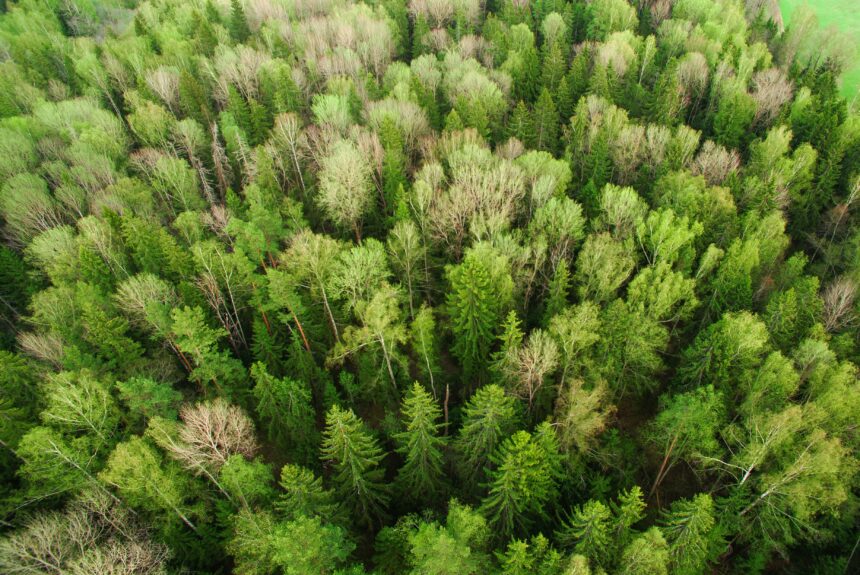Since the dawn of the industrial revolution, carbon dioxide in the atmosphere has increased by 47%. CO2 can last in the atmosphere anywhere from 300 to 1,000 years, which means that most of our past emissions are still hanging around.
>>>READ: The Climate Importance of Carbon Capture
In order to curb the most disastrous effects of climate change, the UN estimates we have to cut greenhouse gas emissions nearly in half by 2030 and achieve net zero by 2050. Doing so will not only require cutbacks on carbon-intensive activities and energy sources; we will also need to find ways to sequester or draw down CO2 from the atmosphere.
Living Carbon’s (Mostly) Natural Solution
Living Carbon, based in San Francisco, is a company that has developed genetically modified trees designed to pull down more CO2 from the atmosphere. The team’s founders, Patrick Mellor and Maddie Hall, met at a conference in 2019, discovering each other’s work and the potential in a shared vision.
Hall was focused on the ability of genetically enhanced trees to produce more biomass and subsequently sequester more CO2. This formed the basis of Living Carbon’s enhancements to photosynthesis. With this technology, the start-up’s trees were able to accumulate 53% more biomass than a control group over a five-month period.
Mellor’s expertise is in mitigating disease and decay in plants. When plant matter decomposes, it releases CO2 back into the atmosphere. By reducing this process and protecting trees from decay, Living Carbon aims to cut back on emissions from forest decay.
In an interview, Mellor describes how tree farms can be used to trap CO2 in wood: “You are perpetually removing carbon dioxide from the atmosphere and storing it in wood. And the more durable the wood, the longer term the storage. All of that woody biomass represents carbon that was drawn down from the atmosphere.”
The result is two-fold: Living Carbon trees draw down more CO2 and emit less back into the atmosphere through decay.
Using Sporopollenin to Store Carbon
While wood is a reliable and familiar carbon store, the company is now investigating a new option: sporopollenin. Sporopollenin forms the outer coating of pollen grains and spores for most land plants and can also be found on certain algae.
Nicknamed “the diamond of the plant world,” sporopollenin is known for its longevity and chemical stability. It’s hard to break down (both physically and chemically), making it an ideal candidate for long-term carbon storage.
The Living Carbon team is working to engineer microalgae to produce more sporopollenin. When mature, the algae could be harvested, dried out, and turned to dust, leaving behind carbon-filled sporopollenin.
Generating Revenue from Carbon Offsets
Living Carbon is already offering carbon credits through monthly subscriptions. For a $40 monthly payment, Living Carbon promises to remove 1 tonne of CO2. They are also looking for partnerships with landowners to help make carbon capture a reliable revenue stream.
>>>READ: Lithos Carbon is Using Enhanced Rock Weathering to Capture CO2
The company will pay landowners to plant their photosynthesis-enhanced trees, use a third party to evaluate carbon capture, and sell carbon credits to corporations looking to reduce their emissions.
Getting off the Ground
Living Carbon received its first carbon purchase earlier this year from Frontier, a collective consisting of Stripe, Shopify, Meta, Alphabet, and McKinsey Sustainability.
Frontier has committed to buying $925M of carbon removal between 2022 and 2030 to support promising carbon removal technologies. Stripe made the first investment, distributing funds to six companies, including Living Carbon.
Living Carbon is exploring further possibilities for carbon capture. Using sporopollenin as a carbon store appears to be a potential game changer, particularly if the company is able to use algae to source it. Private sector innovation such as this will be crucial to reducing emissions and helping us reach our climate goals.
Luke Brennan is a writer and software developer originally from Pittsburgh.
The views and opinions expressed are those of the author’s and do not necessarily reflect the official policy or position of C3.
